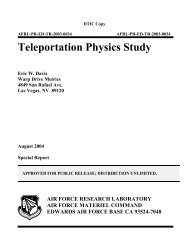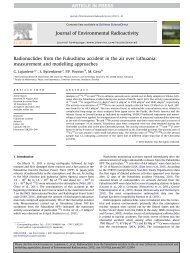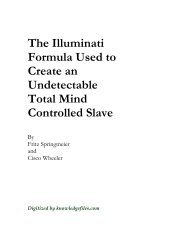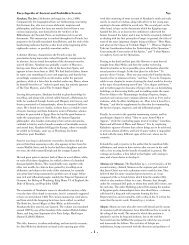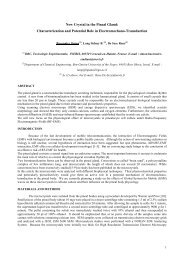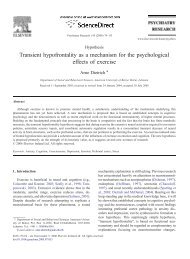Psychology of Terrorism - National Criminal Justice Reference Service
Psychology of Terrorism - National Criminal Justice Reference Service
Psychology of Terrorism - National Criminal Justice Reference Service
Create successful ePaper yourself
Turn your PDF publications into a flip-book with our unique Google optimized e-Paper software.
discriminative stimuli that are temporarily and situationally removed from the circumstances underwhich the discrimination is instructed. The present account illustrates properties <strong>of</strong> rule-governedbehavior with examples from research in instructional control and imitation learning. Units <strong>of</strong>instructed behavior, circumstances controlling compliance with instructions, and rule governedproblem solving are considered.-In contemporary analyses <strong>of</strong> human behavior, the term rule-governed behavior is used to describeresponding determined primarily by instructions; rule governed behavior is commonly distinguishedfrom contingency-shaped behavior that is determined primarily by its direct consequences.39. Clark, R. (1983). Patterns in the lives <strong>of</strong> ETA members . <strong>Terrorism</strong> , 6(3), 423-54.Call Number: Key Quote Summary: Authors Abstract: Based on 48 fairly detailed case histories,and more limited data on 447 other individuals, this article describes significant patterns in the lives<strong>of</strong> members <strong>of</strong> the Basque insurgent organization Euzkadi ta Askatasuna (ETA). The articlediscusses the age and sex <strong>of</strong> ETA members, the socioeconomic background <strong>of</strong> the members and theirfamilies, and their ethnic and linguistic characteristics. The article also describes life in ETA, theradicalization <strong>of</strong> Basque youth, how new members are recruited into the organization, how they liveand what they do as members, how ETA members relate to family, friends, and loved ones, and howthey terminate their relationship to the organization. The study finds ETA members to be not thealienated and pathologically distressed individuals who join other insurgent organizations, but ratherthey are psychologically healthy persons for the most part, strongly supported by their families andtheir ethnic community.-It seems to be fairly widely accepted among investigators <strong>of</strong> insurgent groups that their membersgenerally suffer from distorted or distressed personalities, if they are not in fact insane. Theprevailing view among students <strong>of</strong> political terrorism is that terrorists are, by definition, notpsychologically stable.- Not only are insurgents different, but they are different in a pathological way. My scope is reducedto this single case study.- Euzkadi ta Askatasuna (ETA) the overwhelming majority <strong>of</strong> etarras are well within the range <strong>of</strong>functioning and sane human beings. Members <strong>of</strong> ETA suffer from no greater levels <strong>of</strong> stress thanare observed across Basque society generally etarras have relationships with loved ones that arenormal to the point <strong>of</strong> being mundane. Etarras are not alienated persons; they are, on the contrary,deeply embedded in the culture whose rights they fight to defend.-There are several classes <strong>of</strong> etarras, including liberados, legales, enlaces, apoyos, and buzones, each<strong>of</strong> whom has a specific role to play in the maintenance and support <strong>of</strong> the organization. Relativelyfew etarras actually carry weapons and even fewer have actually carried out assassinations or bankrobberies. My data set consists <strong>of</strong> approximately 23 percent <strong>of</strong> all etarras arrested during theeighteen-month period from January 1979 through June 1980. I use these aggregate data, togetherwith the case studies, to describe for the reader several important characteristics <strong>of</strong> ETA members:the social origins <strong>of</strong> etarras (family, language, class, etc.); the process by which a young Basque istransformed (and recruited) into an ETA member; and , finally, what life is like within ETA, andhow etarras terminate their relationships to the organization.-ETA members tend to be in their middle to late twenties when they join the organization.-The data on sex taken from Table 1 reflect ETA’s pronounced antipathy toward women in theorganization. Fewer than one in ten etarras from the samples were female, and the few women whodo manage to enter the organization are always found among the support or information cells. Wehave few if any actual cases <strong>of</strong> women taking part in a specific armed attack.-As far as social class is concerned, the chances are about even that a typical etarras comes from aworking class or a lower middle class background (about one-third <strong>of</strong> the sample <strong>of</strong> 81 memberscomes from each class). In my review <strong>of</strong> the 81 cases cited here, I found not a single instance <strong>of</strong> anETA member who had come from a farming occupation or even a farming community. Despiteassertions to the contrary that one reads in the popular literature about ETA, I found very few cases<strong>of</strong> etarras who were unemployed. Between four and five out <strong>of</strong> ten etarras were the <strong>of</strong>fspring <strong>of</strong> twoBasque parents (slightly below the average for the Basque population as a whole), while about oneout <strong>of</strong> six was the son <strong>of</strong> two non-Basque parents (less then half the average for the population <strong>of</strong> theBasque provinces generally). Also revealing is the fact that while only about eight percent <strong>of</strong> thepopulation <strong>of</strong> the Basque provinces is <strong>of</strong> mixed ancestry (with one Basque and one non-Basque



